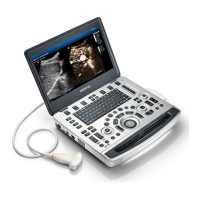6 Image Acquisition
Operator’s Manual 6 - 17
2. Tap [TDI] on the touch screen or the user-defined TDI key to obtain the image.
3. Tap [Free Xros CM] on the touch screen or the user-defined key to enter the mode.
4. Use the trackball to define the start point of the sampling line on the 2D image.
The cursor displays as +, and can be moved within the 2D image only.
5. Press <Set> to fix the start point, and the digital number “1” is marked beside the point.
6. Define the next point using the trackball and <Set> key (tap [Undo] on the touch screen to
cancel the current point and activate the preview point). The system updates the time-motion
curve in real time, and each point is marked with a number in sequence.
7. Repeat Step 6 to finish the sampling line. Double press <Set> to finish the editing.
8. You can edit the curve if needed:
a. After finishing the sampling line, tap [Edit] on the touch screen. The cursor becomes the
icon .
b. Move the cursor over the curve, press <Set> to activate the spot.
c. Move the cursor to change the shape of the curve.
d. Double press <Set> to finish the editing.
NOTE:
Tap [Delete] on the touch screen to remove the curve, and tap [Edit] to re-edit the curve.
9. Adjust the parameters to obtain the desired tissue of Free Xros CM image. Then, save the
image.
10. Press <B> to exit.
6.7.3 Anatomical M Mode Parameters
In anatomical M mode, adjustable parameters are similar with these in M mode.
6.8 PW/CW Mode
PW (Pulsed Wave Doppler) mode or CW (Continuous Wave Doppler) mode is used to provide
blood flow velocity and direction utilizing a real-time spectral display. The horizontal axis
represents time, while the vertical axis represents Doppler frequency shift.
PW mode provides a function to examine flow at one specific site for its velocity, direction and
features; while CW mode proves to be much more sensitive to high velocity flow display. Thus, a
combination of both modes will contribute to a much more accurate analysis.
• During PW/CW mode imaging, menus of image optimizing for B Mode and PW/CW mode are
displayed on the touch screen at the same time; if there is also Color mode (Power mode)
working, menus of certain modes will also be displayed on the touch screen synchronously,
and you can switch by clicking the mode tabs.
• In PW/CW mode, acoustic power of the transducer is synchronous with that of B mode.
6.8.1 PW/CW Mode Image Scanning
Perform the following procedure:
1. Select a premium image during B mode or B+ Color (Power) scan, and adjust to place the area
of interest in the center of the image.

